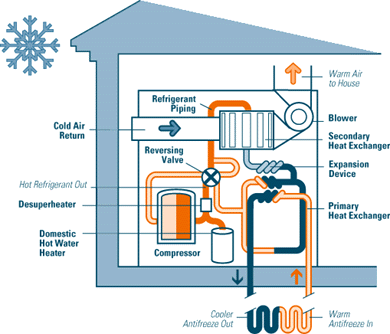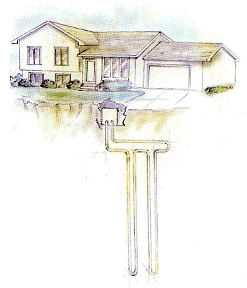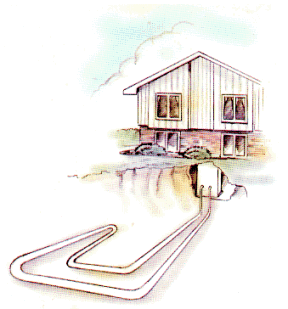|
Although we may not know it heat pumps are very familiar to us - fridges
and air conditioners are two examples. Ground source heat pumps (GSHP) transfer
heat from the ground into a building to provide space heating and, in some
cases, to pre-heat domestic hot water. 
For every unit of electricity used to pump the heat, 3-4 units of heat
are produced. As well as ground source heat pumps, air source and water
source heat pumps are also available.
How does it work?
There are three important elements to a GSHP:
1) The ground loop. This is comprised of lengths of pipe buried in the
ground, either in a borehole or a horizontal trench. The pipe is usually
a closed circuit and is filled with a mixture of water and antifreeze,
which is pumped round the pipe absorbing heat from the ground.
2) A heat pump. This has three main parts:
the evaporator - (e.g. the squiggly thing in the cold part of your fridge)
takes the heat from the water in the ground loop;
the compressor - (this is what makes the noise in a fridge) moves the
refrigerant round the heat pump and compresses the gaseous refrigerant
to the temperature needed for the heat distribution circuit;
the condenser - (the hot part at the back of your fridge) gives up heat
to a hot water tank which feeds the distribution system.
3) Heat distribution system. Consisting of under floor heating or radiators
for space heating and in some cases water storage for hot water supply.
Ground Source Heat Pump
Also called an earth-coupled heat pump, or a geothermal heat pump, a ground-source
heat pump operates much like the common air-source heat pump by transferring
heat, rather than creating it. Unlike air-source, a ground-source heat
pump transfers heat to and from the earth to provide cooling and heating
for your home.
Below the frost line, the temperature of the earth in Nebraska stays
fairly constant at 55°F. In summer, the soil temperature is cooler
than the outside air. In winter, it's warmer. A ground-source heat pump
uses this constant temperature to heat and cool your home very efficiently.
At home with the environment
Geothermal is the most earth-friendly home heating and cooling system
available today. When you install a geothermal system, you're investing
in a home that uses less energy, consumes fewer natural resources and
keeps the air clean and fresh. There's no flame, no flue, no odor and
no pollutants.
Cost-Effective Heating
In the heating season, a ground-source heat pump supplies three to four
units of heat to your home for every unit of electrical energy required
to operate the system. So you get two to three kilowatt hours (kWh) of
free energy for every one kWh of electrical energy you pay for. In other
words, a ground-source heat pump is 300% to 400% efficient.
Vertical Closed-Loop
In a vertical closed-loop ground heat exchanger, a water/antifreeze
mixture is circulated through sealed pipe loops buried in vertical
bore holes. the bore holes are typically 150 to 200 feet deep. As
with a horizontal closed-loop system, heat is transferred by the heat
pump system, from the ground during the winter and to the ground during
the summer. A vertical heat exchanger can be installed on smaller
lots rather than a horizontal system. |
 |
|
|
Horizontal Closed-Loop
In a horizontal closed-loop ground heat exchanger, a water/antifreeze
mixture is circulated through sealed pipe loops buried horizontally,
about six feet underground. During cold weather, the pipe loops absorb
heat from the earth and deliver it to the heat pump located in the
house. The heat pump transfers heat from the loop to warm the air
that is circulated throughout the house by ductwork. The special,
nontoxic antifreeze ensures that the system willnot freeze during
severe winter weather. In the summer, the process is reversed for
air conditioning, and the heat pump system transfers heat from the
house to the ground. |
 |
Well water system
As its name suggests, this system utilizes two wells and underground water.
Water from one well is pumped through the heat pump, then returned to
a second well or discharged into a pond. This system requires three to
five gallons of water per minute, per ton, to operate.
Because water is returned to the earth, the underground water supply
is not depleted by the heat pump's operation.
What are my next steps?
Pick a heating contractor that has experience with installing geothermal
heat pumps.
Ask your heating contractor to accurately evaluate your
home for the installation of a heat pump system. This evaluation
could consist of a computer generated heating analysis showing
the amount of heating and cooling needed to condition your
home for winter and summer.
Request bids for a Standard efficient, Middle efficient,
and a High efficient geothermal heat pump.
Once you receive the bids, have your contractor explain
the EFFICIENCY of the heat pump he or she sells. The efficiency
rating for the heat pump air conditioning cycle is called
the Energy Efficiency Ratio or EER. The EER rating can range
from 10 EER to 24 EER. The efficiency rating for the heat
pump heating cycle is called the Coefficient of Performance
or COP. The COP rating can range from 3 COP to 4.5 COP.
Find out the size of your heating system. This includes
the tonnage of the heat pump and the BTU output of the heating
system.
The important thing to remember is: the larger the EER and
COP rating, the more efficient your heat pump will be .
It is recommended that you purchase the most efficient system
that you can afford. As time goes on, the more efficient
heating system that you buy today will save you money tomorrow.
Benefits/Costs
Geothermal heat pumps offer high efficiency and low operating
cost. According to the EPA, GHPs can save homeowners 30
to 70 percent on heating and 20 to 50 percent on cooling
costs over conventional systems. GHPs provide a high level
of occupant comfort. There is a potential for utility bill
savings, and many local utility companies provide incentives
for investing in GHPs.
The initial cost of a GHP system varies greatly according to local labor
rates, geological profile, type of system installed, and equipment selected.
The initial cost of GHP systems does come at a premium when compared to
air source heat pump systems. For either system, the cost of installed
ducts should be identical. Equipment costs can be 50-100% more expensive
for a GHP system when the circulating pump, indoor tubing, and water source
heat pump are considered. This 50-100% premium translates to $1000 - $2000
for a 3-ton system.
The ground loop is generally the most expensive component of a GHP system
and is highly dependent on local labor rates and drilling conditions.
An installed ground loop stubbed out in a home can run betwee $1000 and
$3000 per installed ton. Overall, one could expect to pay between $4000
and $11000 more for a turnkey 3 ton GHP system than for an air source
heat pump system. Many consumers justify this initial investment with
the savings they expect to realize on their heating and cooling bills
over time.
|